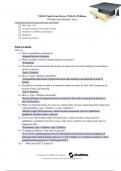lOMoARcPSD|36639652
NR 601 Final Exam Review With Dr. Williams
100 Questions/Multiple Choice
Concept that will be covered on the exam will include:
DM: Types 1 & 2
Urology Concerns in the Geriatric Patient
Alzhheimer’s, Delirium, & Dementia
Menopause
Erectile Dysfunction
★ = that this was mentioned on the review to go back and study on our own.
Week 5 Content
Diabetes
1.) What is prediabetes defined as?
-Impaired glucose tolerance
2.) What is another word for impaired glucose tolerance?
-Prediabetes
3.) Described as an autoimmune destruction of pancreatic beta cells leading to ketoacidosis
& lack of insulin:
-Type 1 Diabetes
4.) How is Type 1 Diabetes described?
-Autoimmune destruction of pancreatic beta cells leading to ketoacidosis & lack of
insulin.
5.) Described as insulin resistance & impaired insulin secretion by islet cells of pancreas &
decline of beta cell function:
-Type 2 Diabetes
6.) How is Type 2 Diabetes described?
-Insulin resistance & impaired insulin secretion by islet cells of pancreas & decline of
beta cell function.
7.) What are important things to assess on a patient that you may suspect/has been diagnosed
with prediabetes, type 1 diabetes, or type 2 diabetes?
-Height/weight, blood pressure, cardiovascular assessment, thyroid, ophthalmic,
peripheral, feet/skin, neuro, and oral.
8.) You’d assess the height/weight, blood pressure, cardiovascular system, thyroid,
ophthalmic, peripheral, feet/skin, neuro, and oral on a patient you suspect may have/is
diagnosed with:
-Prediabetes, type 1 diabetes, type 2 diabetes
9.) To diagnose diabetes, what must be present?
-A1C >6.5%, random glucose level of 200 mg/dL in presence of classic symptoms of
hyperglycemia, fasting plasma glucose of >126 or higher on 2 separate occasions, 2 hour
postload plasma glucose of >200 during OGTT
10.) What does OGTT stand for?
Downloaded by Pala Havard (palaharvard@gmail.com)
, lOMoARcPSD|36639652
-Oral glucose tolerance test
★ Review Table 14.2 in Kennedy Textbook
11.) What topics would you include in treating a patient with diabetes?
-Labs, Lifestyle Changes, Nutrition, Exercise, Vaccines
12.) What labs would you order for a patient with diabetes?
-CMP, lipids, UA, C-peptide, microalbumin once a year, hemoglobin A1C every 3
months
13.) How often should you check a hemoglobin A1C on a patient with diabetes?
-Every 3 months
14.) How often should you check a microalbumin on a patient with diabetes?
-Once a year
15.) How often should you assess lifestyle changes in a diabetic patient?
-Every 3-6 months
16.) What would nutrition education look like for a diabetic patient?
-Meal planning, weight loss of 5%, consistent schedule, avoiding refined sugars, flours,
sugar sweetened beverages, and added sugars.
17.) What should diabetic patients avoid in their diet?
-Refined sugars, flours, sugar sweetened beverages, and added sugars.
18.) What is the exercise goal for a diabetic patient?
-Exercise 3 x’s a week with no more than 48 hours in between, the goal is 150 minutes a
week, individualize each patients exercise plan
19.) What two vaccines are important for diabetic patients to receive?
-Pneumococcal & Influenza
20.) If a patient has Type 1 Diabetes, what medication would you treat them with?
-glargine (Lantus)
21.) Why is glargine (Lantus) the first insulin used in diabetes?
-It is long acting and peakless, patients do not have nearly as many hypoglycemic
episodes with glargine (Lantus)
★ Really need to know and understand the half lives and mechanisms of both. Know if
they are short acting or long acting.
22.) If a patient has Type 2 Diabetes, what medication would you treat them with?
-Glucophage (Metformin)
23.) The first line medication for oral medications in diabetes is
-Glucophage (Metformin)
24.) What is prescribing education/the saying for Glucophage (Metformin)
- “Start low and go slow.”
25.) If you do not “start low and go slow” when prescribing Glucophage (Metformin),
what will most likely happen?
-Patients will have GI effects and quit the medication
Downloaded by Pala Havard (palaharvard@gmail.com)




